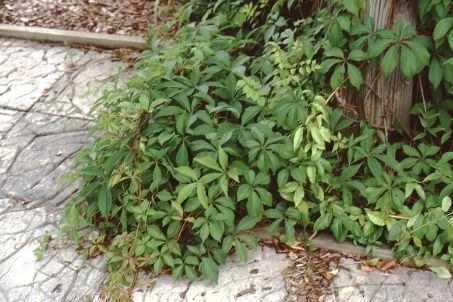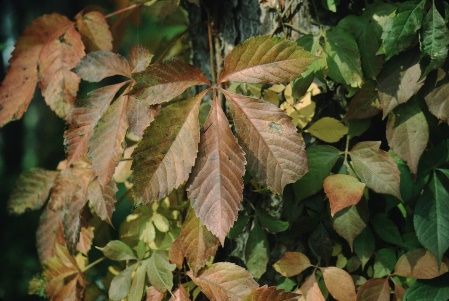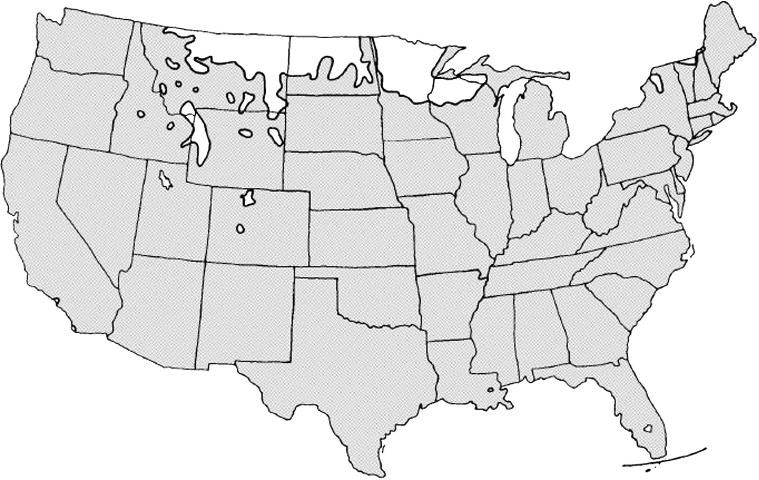Introduction
One of the most attractive deciduous vines, Virginia creeper provides deep green cover to most any object, rapidly climbing by means of tendrils and adhesive disks. The palmately divided leaflets turn a beautiful scarlet color in fall and the bluish-black berries, usually hidden by foliage, are quite attractive to birds. The seeds germinate readily in the landscape and the plant often becomes weedy.

Credit: Edward F. Gilman, UF/IFAS

Credit: Edward F. Gilman, UF/IFAS
General Information
Scientific name: Parthenocissus quinquefolia
Pronunciation: parth-en-no-SIS-us kwin-kweff-FOLE-lee-uh
Common name(s): Virginia creeper, woodbine
Family: Vitaceae
Plant type: ground cover
USDA hardiness zones: 3B through 10 (Figure 3)
Planting month for zone 7: year round
Planting month for zone 8: year round
Planting month for zone 9: year round
Planting month for zone 10: year round
Origin: native to Florida
Invasive potential: native plant that often reproduces into nearby landscapes
Uses: naturalizing
Availability: somewhat available, may have to go out of the region to find the plant

Credit:
Description
Height: depends upon supporting structure
Spread: depends upon supporting structure
Plant habit: spreading
Plant density: moderate
Growth rate: fast
Texture: medium
Foliage
Leaf arrangement: alternate
Leaf type: palmately compound
Leaf margin: serrate
Leaf shape: obovate
Leaf venation: pinnate
Leaf type and persistence: deciduous
Leaf blade length: 4 to 8 inches
Leaf color: green
Fall color: red
Fall characteristic: showy
Flower
Flower color: green
Flower characteristic: spring flowering
Fruit
Fruit shape: round
Fruit length: less than 0.5 inch
Fruit cover: fleshy
Fruit color: purple
Fruit characteristic: persists on the plant
Trunk and Branches
Trunk/bark/branches: not applicable
Current year stem/twig color: brown
Current year stem/twig thickness: thin
Culture
Light requirement: plant grows in part shade/part sun; plant grows in the shade
Soil tolerances: acidic; clay; sand; occasionally wet; loam; slightly alkaline
Drought tolerance: high
Soil salt tolerances: unknown
Plant spacing: 36 to 60 inches
Other
Roots: not applicable
Winter interest: no special winter interest
Outstanding plant: not particularly outstanding
Pest resistance: no serious pests are normally seen on the plant
Use and Management
Virginia creeper can be espaliered against a wall and provides great visual appeal during winter when the leaves have fallen. Stems do not branch readily, so a large number of plants need to be installed to create a dense effect. While ideal for use on buildings or trellises, Virginia creeper should probably not be grown on wood siding. Its tendrils will work themselves between the boards and are difficult to remove. Also, the dense foliage will dry out slowly after a rain, causing a variety of moisture problems for wood siding. It can be established as a ground cover, but the deciduous habit makes it undesirable in the winter.
Growing in full sun to fairly deep shade, Virginia creeper does best on fairly rich soil high in organic matter but will tolerate hot, dry locations.
The cultivar 'Engelmanni' has smaller leaves and denser growth, making it well-suited to small gardens.
Propagation is by seed.
Pests and Diseases
No pests or diseases are of major concern, but Virginia creeper is occasionally bothered by Japanese beetles.